

WELCOME
For over 18 years, SimpliFlying has been a trusted partner to over 125 airlines, airports, and technology firms worldwide. We have been on a mission to help build trust in aviation. To empower the industry to soar to new heights through digitalisation, innovation, and a steadfast commitment to sustainability.
We're not just sought after strategy consultants, we are passionate advocates for meaningful change. Headquartered in Singapore, our global team based out of Canada, India, Spain and the UK is dedicated to equipping aviation and technology executives with the tools, insights, and strategies needed to navigate the complexities of sustainable aviation.
From major airlines and airports to aircraft manufacturers and travel technology companies, our extensive client base underscores our reputation as a trusted partner in the aviation industry since 2008.
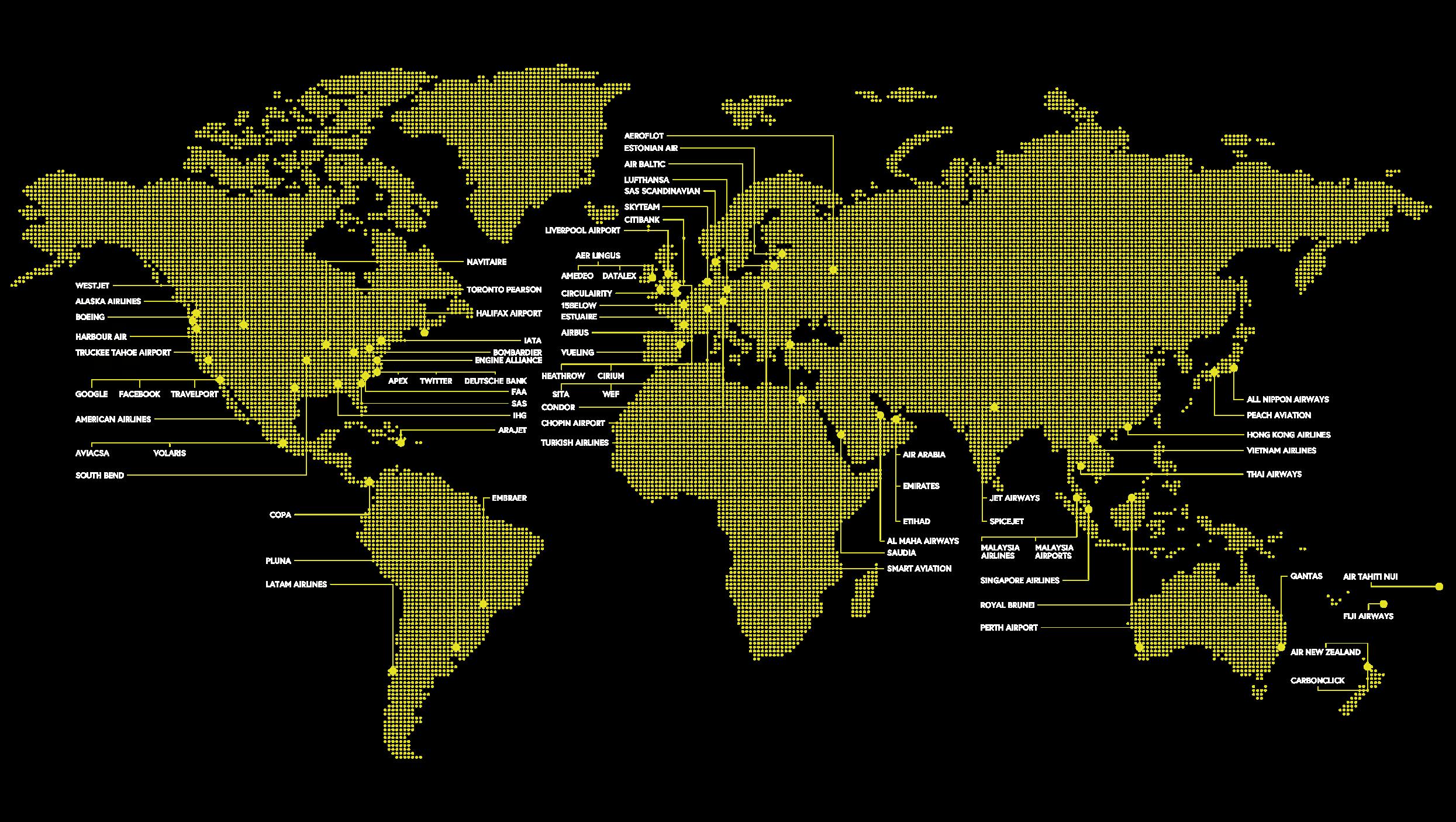
ABOUT THE LEXICON
Welcome to the world of sustainable aviation—a field reshaping how we fly in response to climate and environmental challenges. As the aviation sector evolves, new technologies, policies, and practices are emerging to reduce fuel use, lower greenhouse gas emissions, and limit noise pollution. With these changes comes a wave of new terminology—often complex, technical, and hard to follow.
This lexicon is designed to make that language more accessible. It breaks down key terms and concepts into clear, easy-to-understand entries that provide context and highlight why they matter— especially as aviation moves toward a net-zero future.
Sustainability in aviation is a shared journey. It affects our environment, our economies, and how we stay connected. Whether you work in the industry, follow climate policy, or simply want to understand the changes happening in the skies above, this resource is here to support that understanding.
We hope this lexicon helps you navigate the conversation and take part in shaping the future of flight—no technical background required.
CLIMATE BASICS:
WHAT'S THE PROBLEM?
Paris Agreement
The Paris Agreement is a global climate treaty adopted in 2015 by 196 countries. Its goal is to keep global temperature rise well below 2°C above pre-industrial levels—and to try to limit it to 1.5°C. These limits are critical to avoid the most severe and irreversible effects of climate change.
Each country sets its own national climate plan, called a Nationally Determined Contribution (NDC), which outlines how it will cut emissions and adapt to climate impacts. These plans must be updated every five years and should become more ambitious over time.
Where we are now
In 2024, global temperatures reached about 1.6°C above pre-industrial levels— crossing the 1.5°C threshold for the first time in a calendar year. Scientists say that even one year above this level likely signals a long-term shift, not just a temporary spike.
Two major studies from European and Canadian researchers found that once global temperatures cross a climate threshold, they tend to stay there. This suggests we may already be entering a warmer future beyond the Paris Agreement’s most ambitious target.
Key to know
The Paris Agreement set a global goal to limit warming—but current trends suggest we may already be beyond the 1.5°C limit.
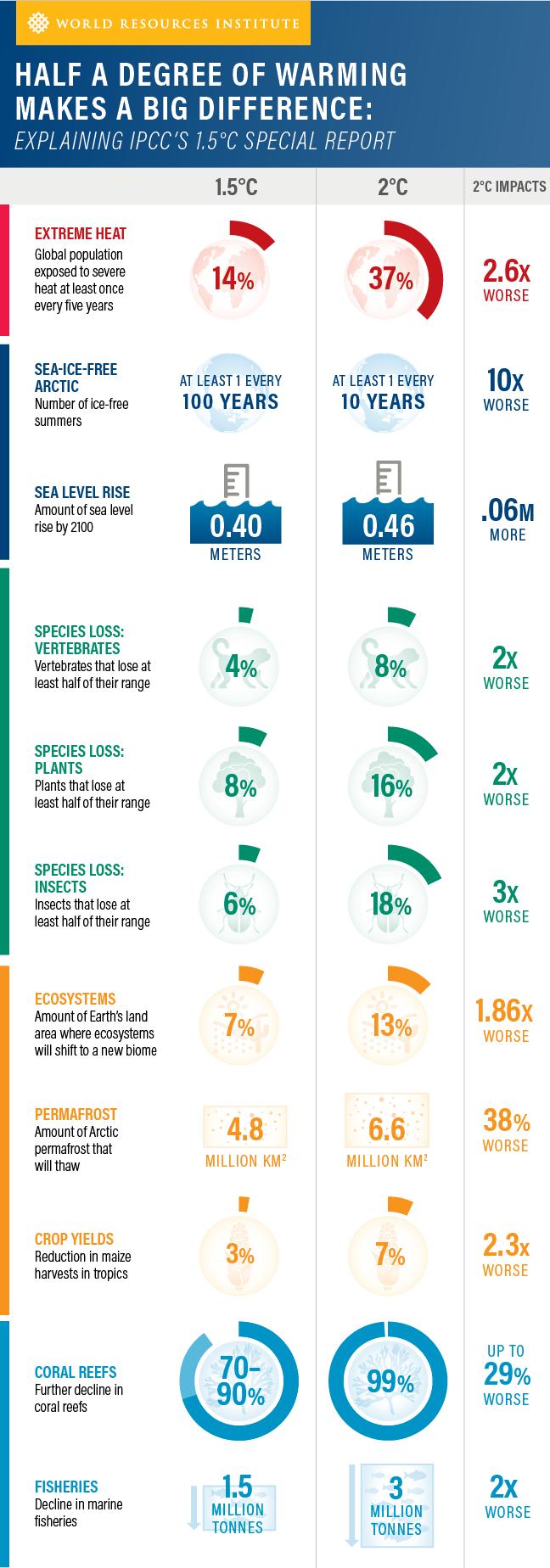
Source: World Resources Institute
Greenhouse gas emissions (GHG)
Greenhouse gases are invisible gases that trap heat in the Earth’s atmosphere—similar to how a greenhouse keeps plants warm. As more of these gases build up, more heat stays in, leading to global warming.
The main greenhouse gases are carbon dioxide (CO2), methane (CH4), nitrous oxide (N2O), and fluorinated gases. They’re released by burning fossil fuels, cutting down forests, farming, and industrial activity.
In aviation, most GHGs come from burning jet fuel. Aircraft also release nitrous oxides, water vapor, and particulates, especially at high altitudes. These non-CO2 emissions can increase warming further, making aviation’s climate impact more complex than CO2 alone.
Key to know
Greenhouse gases are the main drivers of global warming—and emissions at high altitudes, like from aviation, can make the effect even stronger.
CO2 emissions
Carbon dioxide is the most common greenhouse gas, making up about 74% of global emissions. It’s mainly produced by burning fossil fuels for energy, transport, and industry.
In aviation, CO2 is released when jet fuel is burned. In 2023, the sector contributed nearly 2.5% of global energy-related CO2 emissions. While this may seem modest, aviation’s emissions have grown steadily. From 2000 to 2019, it was the fastest-growing transport sector for CO2, outpacing road, rail, and shipping.
After a sharp drop during the COVID-19 pandemic, emissions rebounded quickly— reaching 950 million tonnes in 2023, over 90% of 2019 levels. Domestic travel rose by 30%, and international traffic grew by more than 40% year-on-year, driven largely by recovery in the Asia-Pacific region.
Key to know
CO2 is aviation’s main emission—and it’s rising fast. Reducing it is central to tackling the sector’s climate impact.

Source: Our World in Data
Sources
Air Transport Action Group: Facts & Figures
European Commission: Reducing emissions from aviation
CO2 equivalent (CO2e)
Carbon dioxide equivalent, or CO2e, is a way to compare the climate impact of different greenhouse gases using a single number. Not all greenhouse gases are equal—some trap much more heat than CO2.
CO2e translates the effect of any greenhouse gas into the amount of CO2 that would cause the same level of warming. This makes it easier to measure and report total emissions across sectors and activities.
The aviation sector uses CO2e to account not only for CO2, but also for other emissions like nitrogen oxides, water vapour, and contrails—especially important because these have stronger effects at high altitudes.
Key to know
CO2e helps compare and combine different greenhouse gases by showing their total warming impact in one clear unit.
The conversion is based on a measure called Global Warming Potential (GWP), which compares how much heat a gas traps over time. For example, methane has a GWP of about 27 over 100 years, meaning it warms the planet 27 times more than CO2 in that period.
Non-CO2 emissions
Non-CO2 emissions from aviation include several pollutants that, while less discussed than Co2, significantly contribute to the sector's climate impact.
• Primary among these are nitrogen oxides (NOx), which form ozone at cruising altitudes—a potent greenhouse gas.
• Aircraft also emit water vapour, which ordinarily wouldn't be concerning, but at high altitudes can form contrails and cirrus clouds that trap heat.
• Additionally, aircraft release particulate matter (soot), sulfur oxides, and unburned hydrocarbons.
Key to know
Non-CO2 emissions may be less visible—but they can be just as damaging, especially when released at cruising altitude.
Research suggests that non-CO2 emissions could roughly double aviation’s climate effect compared to CO2 alone. However, these impacts are harder to measure and come with more scientific uncertainty.
Contrails
Contrails—short for condensation trails— are the thin white lines that sometimes appear behind aircraft flying at high altitudes. They form when hot, moist exhaust from jet engines mixes with cold air, causing water vapor to condense and freeze around tiny particles.
Some contrails disappear quickly, but others can spread out and last for hours. These long-lasting contrails can turn into thin, cirrus-like clouds that trap heat in the atmosphere—contributing to global warming.
While contrails can also reflect some sunlight back into space, their overall effect is warming. This impact is especially strong at night, when they trap heat but don’t reflect sunlight.
Key to know
Contrails may look harmless, but they can be a major driver of aviation’s climate impact—especially when they linger and spread.
Research suggests that contrails and the clouds they form could cause as much warming—or even more—than aviation’s CO2 emissions. But the exact impact depends on flight routes, weather, and time of day, and is still being studied.

Photo by hyeok10_12
02
MEASURING EMISSIONS & ENVIRONMENTAL IMPACT
Calculating emissions
Carbon
intensity
Carbon intensity is a way to measure how much greenhouse gas emissions – typically expressed in CO2e – are created for each unit of energy used. In simple terms: the higher the carbon intensity, the more emissions are produced to get the same amount of energy.
Fuels like coal and gasoline have high carbon intensity because they release a lot of emissions when used. Renewable sources like wind or solar have very low carbon intensity because they create energy with little or no pollution.
Key to know
Carbon intensity helps compare how clean different energy sources are. The lower it is, the better for the climate.
Carbon footprint
Key to know
A carbon footprint shows how much your actions contribute to climate change. Measuring it is the first step to cutting it down.
A carbon footprint is the total amount of greenhouse gas emissions caused by a person, organisation, product, or activity. It includes both direct and indirect emissions over the full lifecycle—from production to use and disposal.
For air travellers, this includes the CO2 from the flight itself, plus related emissions like airport transfers. For airlines, it covers aircraft operations, fuel use, ground services, and even emissions from suppliers.
The average carbon footprint in the United States is around 16 tons per person each year—four times higher than the global average of about 4 tons. To meet climate goals, that number needs to drop below 2 tons per person by 2050.
Ecological footprint
Ecological footprint is a way to measure how much of nature’s resources people use to support their lifestyle. It looks at how much land and water is needed to produce the food, materials, and energy we consume—and to absorb the waste we create. This includes everything from farmland and forests to fishing grounds and space for buildings. It’s measured in global hectares (gha), which are units of biologically productive land or water.
When our ecological footprint is larger than what the Earth can renew, we are in ecological overshoot—using resources faster than nature can replace them. This leads to environmental stress and long-term damage.
Unlike a carbon footprint, which only tracks greenhouse gas emissions, ecological footprint covers a wider range of impacts, including food, land use, and materials.
Key to know
Ecological footprint shows whether we’re living within the planet’s limits— or using more than nature can give back.
Scope 1, 2 and 3 emissions
Greenhouse gas emissions are grouped into three categories – Scope 1, 2, and 3 – based on how directly they’re linked to a company’s activities.
• Scope 1 emissions are direct emissions from sources a company owns or controls. For airlines, this includes CO2 from burning jet fuel during flights and on-the-ground operations like maintenance and ground handling.
• Scope 2 emissions are indirect emissions from the energy a company buys—such as electricity, heating, or cooling. For airlines, this includes electricity used at airports, offices, or data centres.
• Scope 3 emissions are all other indirect emissions across a company’s value chain. For airlines, this includes emissions from producing and transporting jet fuel, as well as aircraft manufacturing, maintenance, and even business travel.
Key to know
Scope 1 is direct, Scope 2 is purchased energy, and Scope 3 is everything else. Understanding all three helps measure true emissions.
Scope 3 is usually the largest and hardest to track, but it gives a more complete picture of a company’s total climate impact.
Why aviation’s climate impact is bigger than it looks
Aviation is responsible for about 2–3% of global CO2 emissions. But that figure alone underplays its true impact.
Emissions from flying have doubled since the mid-1980s and reached 950 million tonnes of CO2 in 2023—over 90% of pre-pandemic levels. Fewer than 20% of people worldwide have ever flown, yet aviation's emissions are projected to exceed their 2019 peak by 2025.
And it’s not just CO2. Aircraft also emit nitrogen oxides, water vapor, and form contrails—all of which amplify warming, especially at high altitudes. These non-CO2 effects could double aviation’s overall climate impact.
Sources
Atmosfair: Aviation and Climate Change
Lee et al.: The contribution of global aviation to anthropogenic climate forcing for 2000 to 2018
Carbon budget
A carbon budget is the cumulative finite amount of CO2 emissions that can be released into the atmosphere while still keeping global warming within a certain limit—like 1.5°C or 2°C above pre-industrial levels.
Think of it like a bank account with a fixed balance. Every tonne of CO2 we emit is a withdrawal. Once we spend the entire budget, we risk crossing temperature thresholds that lead to more extreme climate impacts.
Scientists use climate models to estimate how much CO2 we can still emit. These estimates are regularly updated by the Intergovernmental Panel on Climate Change (IPCC).
Key to know
The carbon budget sets a clear limit. The more we emit now, the less room we have to act later.
According to the IPCC's Sixth Assessment Report, at the start of 2020, the remaining carbon budget to stay below 1.5°C was estimated at around 400 gigatonnes of CO2. In 2023, it was projected that this budget would run out in about six years if emissions stayed at current levels—putting us on track to exceed the limit by around 2029.
Direct & Indirect Land Use Change
Land use change happens when land is converted from one use to another—like turning a forest into farmland or building roads through grassland. This can have major environmental impacts by releasing carbon stored in plants and soil.
• Direct land use change (dLUC) refers to changes that happen on the spot and are easy to see and measure. For example, clearing a forest to grow crops is a direct change.
• Indirect land use change (iLUC) is harder to trace. It happens when land is changed somewhere else as a side effect. For instance, using farmland to grow biofuels might push food production to new areas—leading to deforestation elsewhere.
Because iLUC is influenced by global markets and supply chains, it’s more complex to calculate and often debated in climate policy.
Key to know
dLUC is visible and local; iLUC is hidden and global. Both matter when assessing the real climate impact of land-based activities like farming or biofuel production.
CLIMATE GOALS:
WHERE ARE WE HEADING?
Net zero
Net zero means balancing the amount of GHG emissions released with the amount removed from the atmosphere. The goal is to make sure that human activity no longer adds extra warming to the planet.
To reach net zero, emissions must be reduced as much as possible—by improving efficiency, switching to clean energy, and changing how things are made and moved. Any remaining emissions must then be removed, for example through carbon capture or planting trees.
Key to know
Net zero isn’t about doing nothing— it’s about cutting emissions deeply, then balancing out what’s left.
Carbon neutrality
On the other hand, carbon neutrality means balancing out CO2 emissions by funding projects that remove or reduce emissions elsewhere—like planting trees, building renewable energy, or using carbon capture technology.
Key to know
Carbon neutrality is mostly about offsetting emissions rather than reducing them at the source.
Unlike net zero, carbon neutrality doesn’t require cutting emissions directly. Instead, it focuses on measuring emissions and then offsetting them through certified programmes.
It may cover a wide range of emissions, but including Scope 3 (indirect emissions from things like suppliers or customers) is not always required.
Net zero and carbon neutrality are related concepts that aim to achieve the same end result: removing harmful emissions from the Earth’s atmosphere. However, there are distinctions in the scale and kind of emissions removed with the differentiating factor being compensated emissions (aka offsets). (source)
Zero carbon
Zero carbon means that a product or service does not produce any CO2 emissions from the start. There’s no need to offset or remove emissions because none are released in the first place. This usually applies to things designed to run entirely on clean energy—like buildings powered by solar or wind, or electric vehicles charged from renewable sources.
Difference between a net-zero airline and a carbon-neutral airline
In the aviation context, most airlines are considering carbon neutrality as an interim goal on the way to flying truly net zero.
This is because carbon neutrality is easier to achieve with the existing tools and systems and can be done through offsetting without necessarily requiring changes to other processes. Therefore, airlines are setting interim goals by 2023 or 2040 where the focus is primarily on addressing CO2 emissions through operational efficiencies or carbon offsetting initiatives.
Net zero is a more ambitious goal usually set for 2050 or 2060 by when all airline emissions would effectively be cancelled out by activities that avoid, remove or reduce all greenhouse gases, not only CO2. Of course, this requires significant investment, technological and operational changes, such as the global supply of SAF and the adoption of next-generation aircraft.
It's worth mentioning that while carbon offsetting can help companies reduce their overall carbon footprint, it is still going to be a controversial practice. Some critics argue that offsetting allows companies to buy their way out of their environmental responsibility and that it could be more effective for companies to reduce their emissions directly.
Decoupling
Decoupling means separating economic growth from environmental harm. In other words, it’s about growing the economy without increasing pollution, emissions, or resource use at the same rate.
There are two types:
Key to know
Decoupling shows whether we can grow without doing more harm to the planet—and how fast we’re making that shift.
• Absolute decoupling happens when the economy grows but environmental impacts, such as resource use or pollution, stay the same or even go down.
• On the other hand, relative decoupling means impacts are still rising, but more slowly than the economy is growing.
Decoupling is often measured by comparing things like CO2 emissions or resource use to GDP. The goal is to reduce pressure on the environment, even as industries and economies expand.

Photo by LeBonVieuxMax
POLICY, FRAMEWORKS & ACCOUNTABILITY
CORSIA
The Carbon Offsetting and Reduction Scheme for International Aviation (CORSIA) is a global programme created by the International Civil Aviation Organization (ICAO) to help limit carbon emissions from international flights.
Here’s how it works: if an airline’s CO2 emissions go above a set baseline (based on 2019–2020 levels), it must “make up” the extra emissions by investing in projects that reduce CO2 elsewhere—like renewable energy or reforestation. This is known as carbon offsetting (see page 39).
The goal is to make sure that any growth in international air travel after 2020 doesn’t lead to higher overall CO2 emissions from aviation.
Why it matters
• CORSIA is the first global scheme tackling emissions from a single industry.
• It encourages cleaner technologies by putting pressure on airlines to reduce emissions or offset them.
• Airlines have flexibility in how they meet their offsetting requirements—by cutting their own emissions, buying credits, or funding offsets.
Key to know
Criticisms
• Critics argue that it relies heavily on offsetting, rather than reducing emissions directly.
• It only covers international flights—not domestic ones.
• Participation was voluntary at first, and not all countries have joined.
• It doesn’t address non-CO2 effects, like contrails or nitrogen oxides, which also contribute to warming.
CORSIA aims to cap emissions from international flights—but it’s just one piece of the puzzle, and it doesn’t replace the need for deeper cuts.
SBTi
The Science Based Targets initiative (SBTi) helps companies and financial institutions set climate goals that align with what science says is needed to limit global warming.
To qualify, companies must set targets to reduce their greenhouse gas emissions in line with the goal of keeping warming below 1.5°C. SBTi provides a clear pathway—showing how much they need to cut, and how fast, based on the latest climate science. These are called “science-based targets” because they reflect what is needed to avoid the most severe impacts of climate change.
Once targets are approved, companies must report progress each year. There are no legal or financial penalties for falling behind, but the main consequence is reputational—companies can be removed from the SBTi list if they fail to report or show progress.
SBTi was founded by CDP, the UN Global Compact, WRI, and WWF. It became an independent UK charity in 2023, with a separate arm—SBTi Services Ltd.—that reviews and approves company targets. While SBTi plays a leading role in corporate climate action, it has faced criticism for a lack of transparency in how targets are reviewed and for limited enforcement of its standards.
Key to know
SBTi helps turn climate science into corporate action—but relies on public accountability, not regulation.
EU ETS
The European Union Emissions Trading System (EU ETS) is the world’s first and largest carbon market. Launched in 2005, it is a type of carbon market, often referred to as a "cap-and-trade" system, which aims to reduce greenhouse gas emissions from major polluters across Europe.
How it works
• Cap: A limit is set on the total emissions allowed from all participating sectors— like power generation, heavy industry, and aviation. Each year, the EU lowers the cap slightly, meaning the total emissions from these sectors must reduce accordingly.
• Trade: Companies are given a set number of carbon allowances—each one lets them emit one tonne of CO2. If they emit less, they can sell their spare allowances. If they need more, they must buy them.
• Carbon price: The trading of allowances creates a market price for carbon, which is the cost per tonne of CO2 emitted. The higher the price, the more it encourages companies to cut emissions.
Why it matters
Aviation and the EU ETS
The EU ETS covers around 11,000 facilities across the EU and is the largest carbon market in the world, but it's not the only one. There are several others, including the California Cap-and-Trade Program, the Regional Greenhouse Gas Initiative (RGGI) in the northeastern United States, and the Chinese national carbon market Each of these operates similarly to the EU ETS, but with different caps, participants, and regulations. Since 2012, the EU ETS has also included aviation. Airlines flying within Europe must monitor, report and verify their CO2 emissions—and buy or trade allowances to cover them.
• It gives airlines a financial reason to reduce emissions.
• It uses a market-based approach instead of strict regulation.
• As aviation is global, improvements in one region can have broader climate benefits.
Key to know
The EU ETS puts a shrinking cap on emissions and a growing price on carbon— pushing airlines and industries to lower their climate impact over time.
IATA Net Zero Resolution
The IATA Net Zero Resolution is a global commitment by the airline industry to reach net zero carbon emissions by 2050. It was adopted in 2021 by the International Air Transport Association (IATA), which represents around 290 airlines—about 83% of global air traffic. Reaching this goal is ambitious and depends heavily on new technologies and cleaner fuels. The industry’s net zero plan is based on four key pillars:
• Sustainable aviation fuel (SAF) –expected to deliver about 65% of the needed emissions cuts
• New aircraft technology – including electric and hydrogen-powered planes (13%)
Key to know
The IATA Net Zero Resolution sets a global target for airlines—but achieving it will require big changes, especially in fuel and aircraft technology.
• Operational and infrastructure improvements – such as better air traffic management (3%)
• Carbon capture and offsetting – to handle any remaining emissions (19%)
While the resolution signals strong industry intent, experts—including IATA itself—have acknowledged that hitting the 2050 target will be difficult without a major scale-up in SAF production and continued innovation.
Low Carbon Fuel Standard
The Low Carbon Fuel Standard (LCFS) is a California regulation that cuts GHG emissions from transport by rewarding the use of cleaner fuels in the state. It works by setting a carbon intensity (CI) limit—fuels that pollute less earn credits, while more polluting fuels generate deficits. Companies must trade credits to stay compliant, creating a financial incentive to lower emissions.
Carbon intensity is based on a fuel’s entire life cycle—from production to use—and includes all major greenhouse gases, not just CO2.
Since 2011, the LCFS has helped replace 25 billion gallons of petroleum-based fuel with cleaner alternatives like electricity, hydrogen, and biofuels—improving air quality and cutting emissions across the state. It is estimated that due to the LCFS, California's GHG emissions had declined by 20% in 2022, compared to 2000 levels, with the largest reductions coming from the transportation sector.
Aviation relevance
Sustainable aviation fuel has been eligible for LCFS credits since 2018. This helps reduce the cost of SAF and supports investment in lower-carbon aviation.
Key to know
LCFS uses carbon intensity rules and credit trading to drive cleaner fuel use—including in aviation.
Renewable Energy Directive
The Renewable Energy Directive (RED) is an EU law that promotes the use of renewable energy across all member states. First adopted in 2009, it has been updated several times to match the EU’s growing climate goals. The latest version, RED III, was adopted in 2023.
What RED III sets out to do
• Increase renewables: At least 42.5% of the EU’s total energy must come from renewable sources by 2030—with a stretch goal of 45%.
• Clean up transport: At least 29% of transport energy must come from renewables by 2030.
• Within that, 5.5% must come from advanced biofuels and renewable fuels of non-biological origin (RFNBOs).
• At least 1% must come specifically from RFNBOs.
• Cut emissions: Transport fuels must reduce their GHG intensity by 14.5% by 2030.
• Speed up deployment: RED III makes it easier and faster to approve new renewable energy projects.
Aviation relevance
RED III directly supports the use of sustainable aviation fuel in Europe by setting targets for advanced fuels and RFNBOs. These targets create demand and regulatory support for SAF production and uptake.
Key to know
RED III is the EU’s legal engine for scaling up renewables—and it gives a strong push to cleaner fuels in aviation.
Renewable Fuel Standard
The Renewable Fuel Standard (RFS) is a U.S. federal program that promotes the use of renewable fuels to cut GHG emissions and reduce reliance on imported oil. It was launched in 2005 and expanded in 2007, and it’s managed by the Environmental Protection Agency (EPA).
Each year, the RFS sets targets for how much renewable fuel—like ethanol, biodiesel, or advanced biofuels—must be blended into transportation fuels such as gasoline and diesel. Fuel refiners and importers, called obligated parties, must meet these targets.
How tracking works
The system uses Renewable Identification Numbers (RINs)—unique codes assigned to each gallon of renewable fuel. Producers generate RINs, and obligated parties collect and trade them to prove they’ve met their renewable fuel obligations. Once used for compliance, RINs are retired. This market-based approach gives companies flexibility in how they meet their targets, while maintaining transparency and accountability.
Key to know
The RFS is the U.S. policy engine for renewable fuels—using a credit system (RINs) to track progress and drive cleaner fuel use.
45Z Clean Fuel Production Credit
The 45Z Clean Fuel Production Credit is a U.S. federal tax incentive created under Section 45Z of the Internal Revenue Code, effective from January 1, 2025. It’s designed to support domestic production of cleaner fuels by rewarding producers based on the fuel’s emissions performance—the lower the emissions, the higher the credit.
To qualify, the clean fuel must meet several key criteria. It must be produced at a qualified facility located in the US, registered with the IRS under specific categories, and must be sold for use in a business or for retail. It must reduce emissions by at least 50% compared to a set baseline and cannot be made using fossil fuel co-processing. Producers also cannot claim this credit if they are already receiving related federal incentives like those for clean hydrogen (45V) or carbon capture (45Q).
Why it matters for aviation
The 45Z credit is especially important for aviation because it supports the production of sustainable aviation fuel (SAF). SAF producers can earn a higher credit rate if they meet additional criteria—such as paying prevailing wages and offering apprenticeships. This helps reduce production costs and makes SAF more competitive with fossil jet fuel.
Key to know
The 45Z credit rewards cleaner fuel production—and plays a role in scaling up SAF for aviation’s lowcarbon future.
Environmental, social, and governance (ESG)
ESG is a management framework used to understand how a company manages risks and opportunities related to sustainability—not just environmental issues, but also how it treats people and how it's run.
It’s often used by investors to evaluate companies, but it's also important to customers, employees, and suppliers who care about responsible business practices.
What ESG covers
• Environmental: How the company impacts nature. Does it use a lot of energy or water? Is it reducing pollution or helping protect the planet?
• Social: How the company treats people. This includes workers, customers, and communities. Are they fair, inclusive, and supportive?
• Governance: How the company is led and managed. Is leadership transparent? Are decisions made responsibly and legally?
Together, ESG gives a fuller picture of how sustainable and ethical a business really is.
Key to know
ESG helps measure how responsibly a company operates—from climate impact to people policies to corporate leadership.
05
STRATEGIES FOR MANAGING EMISSIONS
Carbon offsetting
Carbon offsetting is when a company or individual compensates for their own CO2 emissions by funding projects that remove or reduce emissions elsewhere—like planting trees or building renewable energy.
Offsets offer flexibility, allowing organisations to support climate projects even if they can’t cut all their emissions right away. But they are controversial. Critics argue that offsets can delay real action, giving the impression of progress without actual cuts— especially if the offsets are low-quality or poorly verified.
When should offsets be used? What makes a good offset?
Offsetting should be a last resort, used only after all possible emissions have been reduced. If used, they should meet clear standards and be transparently communicated—not just chosen for low cost or convenience.
Principles for using offsets responsibly
• Evaluate the programme thoroughly
• Don’t choose based on price alone
• Avoid deforestation protection credits
• Prioritise local or community-based projects
• Be transparent about how offsets are used
• Stay focused on long-term emission reductions and net zero
Key to know
Two key principles are:
• Additionality: The project must lead to emissions reductions that wouldn't have happened without the offset funding. If a project was already going to happen, the offset doesn’t really cancel out emissions.
• Permanence: The carbon must stay out of the atmosphere for the long term. If a forest later burns or is cleared, the carbon is released again—undoing the benefit. To manage this risk, many offset programmes use buffer reserves—pools of credits set aside from multiple projects as insurance. If one project fails (for example, due to wildfire), the buffer covers the loss. This works better for natural risks than for human-caused ones like illegal logging.
Offsets should never replace real reductions. When used, they must be additional, permanent, and part of a credible plan to reach net zero.
Carbon removal
Reaching net zero won’t be possible through emissions cuts alone. We also need to remove carbon that’s already in the air, and carbon removal makes this possible.
Carbon removal refers to any process that takes CO2 out of the atmosphere and stores it for decades—or even centuries through different means, e.g., in trees, soils, underground reservoirs, rocks, the ocean and even products like concrete.. This is different from simply reducing emissions. It’s about actually reversing them.
There are three main strategies of carbon removal:
• Natural: Restoring forests, improving soil, or planting carbon-rich crops. These are the most immediately available, large-scale options—especially in countries like the U.S.
• High-tech: Tools like direct air capture (DAC) use machines and chemical reactions to pull CO2 directly from the air.
• Hybrid: Strategies like bioenergy with carbon capture and storage (BECCS), or engineered crops that store more carbon in their roots.
Carbon removal is especially useful for balancing out emissions from industries that are hard to decarbonise—like aviation or cement. It can also help undo past emissions, not just avoid new ones. air,
Key to know

Source: Exterra Carbon Solutions
Carbon Capture vs Direct Air Capture: What’s the difference?
• Direct air capture (DAC) pulls CO2 from the air around us. It helps lower the total concentration of carbon in the atmosphere.
• In contrast, carbon capture and storage (CCS) traps CO2 at the source—like power plants or factories—before it ever reaches the air. The captured CO2 is then stored underground.
Both strategies aim to mitigate the effects of CO2 on climate change, but they target different sources of emissions and use different methods.
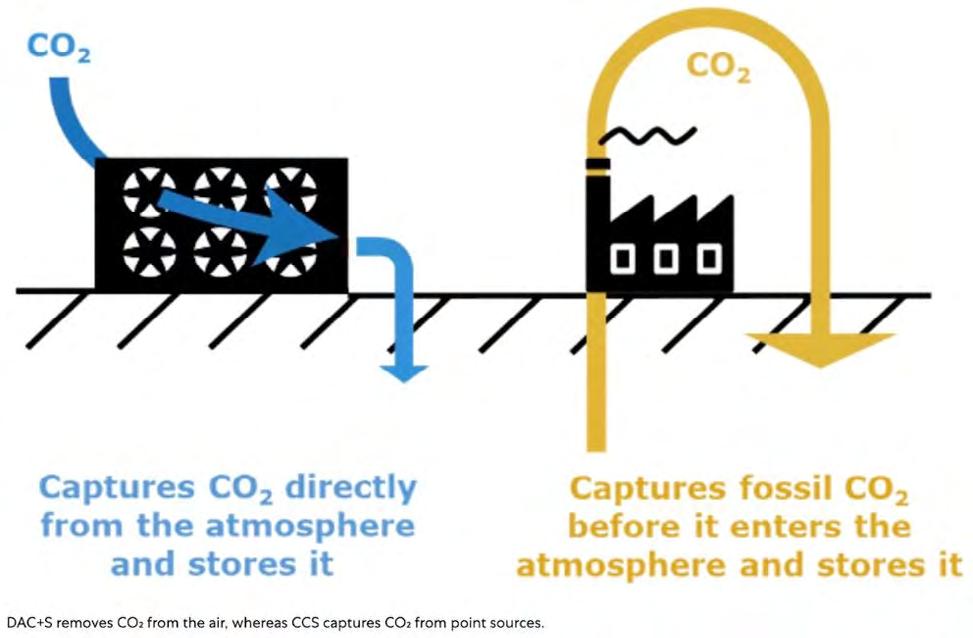
Source: Climeworks
Key to know
Carbon removal goes beyond reducing emissions. It pulls carbon out of the air and locks it away—playing a critical role in reaching net zero.
Read our report on some of the most exciting companies to watch out for in this space
Carbon credit
A carbon credit is a tradable certificate that represents one tonne of CO2—or its equivalent in other greenhouse gases—being reduced, avoided, or removed from the atmosphere.
These credits are created by verified climate projects like tree planting, renewable energy, or methane capture. They can be bought and sold on carbon markets, and are often used by companies or governments to offset their own emissions.
How it works
• Verification: Credits are issued according to strict rules by standards bodies like Verra or Gold Standard. Projects must prove the emission cuts are real, measurable, and additional— that is, they wouldn’t have happened without the credit funding.
• Registration and retirement: Verified credits get a unique serial number and are listed in public registries. Once a credit is used to offset emissions, it is retired, meaning it can’t be reused or sold again.
• Market value: The price of a credit depends on the type of project, where it’s located, and any extra benefits— like helping biodiversity or supporting local communities. Nature-based credits often carry a premium.
Key to know
A carbon credit represents a real emissions cut. But it only counts once—and only if it’s verified and properly retired.
Carbon insetting
Carbon insetting is when a company reduces GHG emissions by investing in climate projects within its own value chain—rather than offsetting emissions through external projects.
Insetting focuses on emissions directly linked to a company’s operations, suppliers, or products (Scope 1, 2, or 3). It helps build resilience, improve sustainability, and create long-term value inside the business.
Key features of insetting
• Value chain focus: Insetting targets emissions within the company’s supply chain—such as through sustainable sourcing, clean energy, or better farming practices.
• Nature-based solutions: Projects often include reforestation, agroforestry, regenerative agriculture, or renewable energy.
• Local and social benefits: Insetting often supports the communities and ecosystems a company relies on, creating both climate and social impact.
• Strategic alignment: Insetting embeds sustainability into core operations, helping reduce risk and support net zero goals.
In aviation
While airlines have traditionally used carbon offsetting, this approach is increasingly criticised for lacking real impact. Harbour Air is one of the first to use insetting strategy—it adds a sustainability fee to each flight and invests that money into developing electric aircraft. Instead of buying offsets, the airline funds internal innovations that reduce emissions from the source.
Key to know
Insetting means tackling emissions from within—making climate action part of how a company does business.
Listen to our podcast interview to learn more about Harbour Air's innovative insetting approach
Sustainable Aviation Fuels (SAF)
Sustainable aviation fuels (SAF) are non-fossil alternatives to conventional jet fuel. Produced from renewable or recycled sources, SAF offers significantly lower lifecycle emissions and is one of the most promising tools for decarbonising aviation.
According to IATA, SAF could provide up to 65% of the emissions reductions needed for the aviation sector to reach net-zero CO2 by 2050. SAF is certified to meet the same performance standards as fossil jet fuel, making it a drop-in fuel that works with today’s aircraft and fueling systems.
SAF comes in two main forms: advanced biofuels and synthetic fuels (often referred to as e-fuels).
Key to know
SAF includes both bio-based and synthetic fuels. Biofuels are already in use, but limited by feedstock. E-fuels have greater long-term potential—especially if powered by renewables and supported by policy and investment.
Biofuels
Biofuels, also known as biojet, are made from biological materials such as plants, waste oils, agricultural residues, and certain sugars. They reduce emissions by replacing fossil fuels with renewable carbon sources and are already in commercial use.
The environmental performance and scalability of biofuels depend on the feedstock:
• 1st Generation (1G): Edible oils like soybean, palm, or corn. Low cost, but linked to deforestation and food competition. Use is declining.
• 2nd Generation (2G): Non-edible waste fats, oils, and greases (FOGs), such as used cooking oil and animal fats. More sustainable and widely used today, especially via HEFA.
• 3rd Generation (3G): Algae, municipal solid waste, forestry residues, and energy crops grown on degraded land. Abundant and promising, but not yet widely scaled.
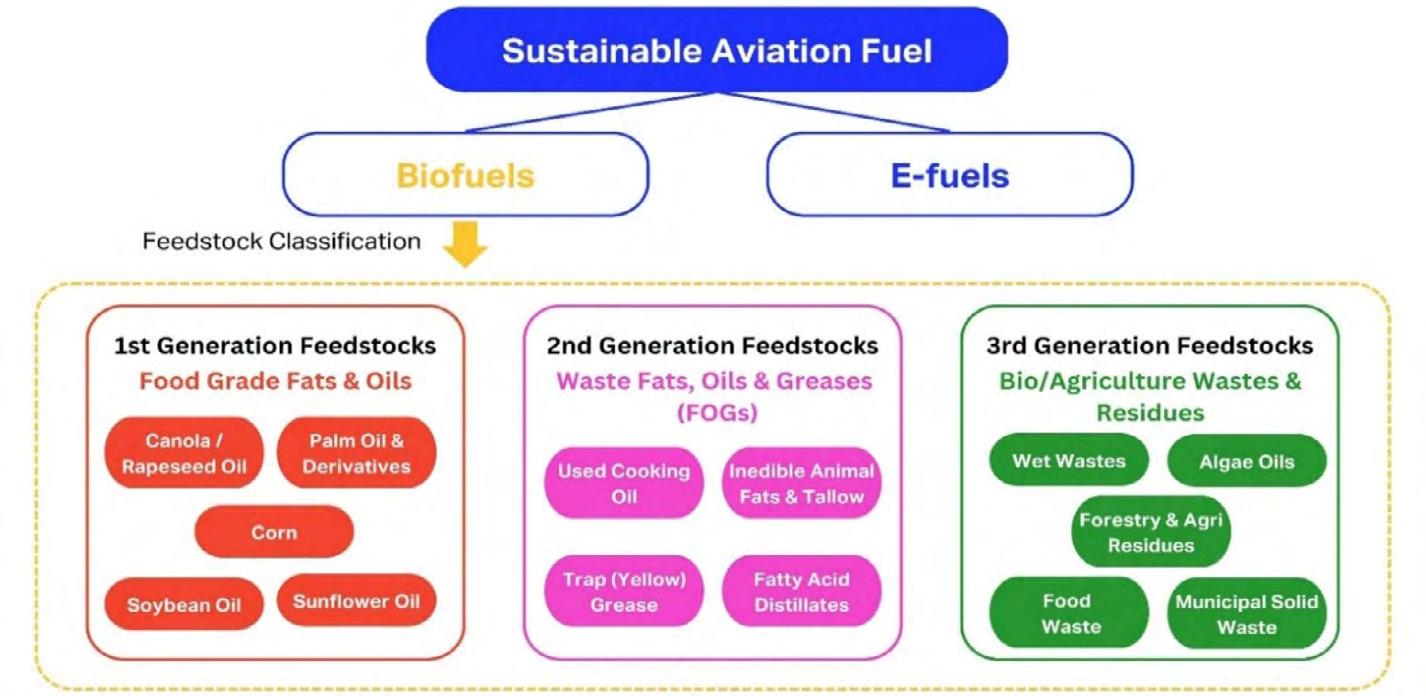
Source: IATA
Industry spotlight: Gevo
Gevo is a U.S.-based company producing SAF from renewable alcohols like ethanol. With its Net-Zero 1 facility in development, Gevo is building one of the first fully integrated SAF plants designed to achieve net-zero lifecycle emissions. Gevo’s tracking system monitors carbon intensity from farm to flight, enabling precise climate impact accounting and greater transparency for buyers.
Hear more from Gevo’s CEO, Dr. Patrick Gruber, in our podcast episode about scaling SAF.
Synthetic fuels (e-fuels)
Synthetic fuels, or e-fuels, are made by combining renewable electricity, water, and captured CO2 to create liquid hydrocarbons. Unlike biofuels, they don't rely on landbased feedstocks, which helps avoid concerns like deforestation, biodiversity loss, and competition with food crops.
However, e-fuels come with their own challenges. Their overall climate benefit depends entirely on:
• The use of low-carbon electricity
• The source of CO2 (ideally from direct air capture or biogenic sources)
• The efficiency of the conversion process
E-fuels are energy-intensive to produce and currently much more expensive than both fossil jet fuel and bio-based SAF. Scaling up requires massive investment in clean energy infrastructure and electrolyser capacity, as well as reliable access to sustainable CO2.
Despite this, e-fuels offer some long-term advantages:
• Ultra-low lifecycle emissions, especially if powered by surplus renewable energy
• No land-use or biodiversity trade-offs, compared to many biofuel feedstocks
• Potential for closed-loop carbon recycling, especially when paired with DAC (direct air capture)
Industry spotlight: Twelve
U.S.-based company Twelve produces E-Jet®, a synthetic SAF made from CO2, water, and renewable electricity. The process uses electrochemical carbon transformation to create hydrocarbons with up to 90% lower lifecycle emissions. E-Jet® meets ASTM standards and can be blended up to 50% with fossil jet fuel.
Listen to our podcast interview with Twelve CEO Nicholas Flanders to learn how synthetic fuels are moving from lab to runway.
Production pathways
As of late 2024, ASTM has approved eight SAF production pathways, each with its own feedstock compatibility and carbon footprint. Key methods include:
• HEFA (Hydroprocessed Esters and Fatty Acids): Converts waste oils into jet fuel using hydrogen. Most commercially mature but limited by feedstock availability.
• AtJ (Alcohol-to-Jet): Turns ethanol or butanol into jet fuel using chemical processes. Can use diverse waste biomass.
• FT-SPK / FT-SAK (Fischer-Tropsch): Converts gasified solid or gas feedstocks into liquid hydrocarbons. FTSAK includes aromatics needed for full jet fuel compatibility.
Power-to-Liquid
Power-to-Liquid (PtL) is a key synthetic SAF pathway. It combines green hydrogen (produced via electrolysis) with captured CO2 to create jet fuel, typically using Fischer-Tropsch synthesis. The result is a liquid fuel compatible with today’s aircraft and infrastructure.
• CHJ (Catalytic Hydrothermolysis): Uses high-temp water and catalysts to convert fatty acids into fuel.
• SIP (Synthesised Iso-Paraffins): Biologically produces jet fuel from sugars, but with limited blending potential.
SAF is typically blended with fossil jet fuel in proportions of up to 50%, depending on the pathway. Co-processing also allows renewable feedstocks to be processed within traditional refineries, easing the transition without major infrastructure changes—but traceability is key.
While PtL SAF faces a longer development timeline than advanced biofuels, it is expected to play a critical role in decarbonising aviation at scale— particularly in regions with abundant renewable energy and limited bio-based feedstock.
Book and Claim
Book and Claim is a system that allows the climate benefits of SAF to be claimed—even if the fuel isn’t used on a specific flight. Instead of physically delivering SAF to every airport, the fuel is added where infrastructure exists, and its environmental benefit is recorded separately.
That benefit is captured in a SAF Certificate (SAFc)—a digital record representing one tonne of SAF and its verified emissions savings. Airlines, corporate travellers, or other buyers can purchase these certificates and claim the climate benefit, even if their own flight doesn’t physically use the SAF.
To ensure transparency, all certificates are tracked through a SAFc Registry, which assigns a unique serial number, verifies sustainability claims, and prevents doublecounting. IATA is developing a global registry to standardise this process across the aviation industry.
Key to know
Book and Claim enables wider access to SAF by letting the climate benefit travel—even when the fuel doesn't.
Sustainability certifications
Sustainability certification for aviation fuels involves independent third-party verification that a fuel meets specific environmental criteria throughout its lifecycle. This process is essential for ensuring that SAF deliver genuine climate benefits without causing environmental harm elsewhere, addressing concerns about issues like deforestation, biodiversity loss, water usage, and community impacts.
RSB
The Roundtable on Sustainable Biomaterials (RSB) is often considered the gold standard for sustainability certification of biofuels and biomaterials, including sustainable aviation fuel. Based in Switzerland and active since 2007, RSB offers a rigorous certification framework that goes far beyond GHG emissions. Its twelve principles cover:
• Human rights and labour conditions
• Food security and rural development
• Soil, water, and air protection
• Biodiversity and conservation
For aviation, RSB has created tailored SAF standards and its own Book and Claim system, ensuring traceability of sustainability attributes even when the fuel is used elsewhere.
ISCC
The International Sustainability and Carbon Certification (ISCC) system is a global certification system that verifies both the sustainability of feedstocks and GHG reductions for fuels, including SAF.
There are two main programmes:
• ISCC EU: Aligned with EU’s Renewable Energy Directive (RED)
• ISCC PLUS: Used for voluntary claims and global markets
GREET
ISCC certification includes criteria such as:
• Minimum 50–65% lifecycle GHG reductions
• No sourcing from high-biodiversity or high-carbon-stock land
• Compliance with labour rights and good agricultural practices
The Greenhouse gases, Regulated Emissions, and Energy use in Technologies (GREET) model is a lifecycle assessment tool developed by Argonne National Laboratory in the U.S. It’s used to calculate the full environmental impact of fuels, including SAF—tracking emissions and energy use from production to consumption.
In 2024, a new version of GREET was released to support U.S. SAF tax credits under the Inflation Reduction Act (IRA). This version is known as 40B SAF-GREET 2024 and provides the official framework for evaluating which SAF producers qualify for federal incentives:
• Climate-smart farming rules for corn-ethanol SAF (no-till, cover crops, improved fertilisers)
• A required 50% GHG reduction threshold to qualify for federal incentives
• Penalties for land use change if forests or croplands are converted to biofuel production
ASTM D7566
ASTM D7566 is the international fuel standard that sets the safety and quality rules for sustainable aviation fuel and other synthetic jet fuels. It was developed by ASTM International, an organisation that creates technical standards used worldwide. While traditional jet fuel is covered by a different standard (ASTM D1655), D7566 applies specifically to fuels made from non-petroleum sources—like waste oils, plants, or captured carbon—using approved synthetic processes.
To be listed under D7566, a SAF production method must pass a long testing process (ASTM D4054) that checks if the fuel is safe and compatible with aircraft systems. Once approved, SAF can be blended with conventional jet fuel—typically up to 10–50%, depending on the pathway.
The final fuel blend is then re-certified under ASTM D1655, making it a drop-in fuel that can be used in today’s aircraft without any changes to engines or fueling systems.
Key to know
ASTM D7566 is the global standard that ensures SAF is safe, reliable, and ready to fly.

Photo by Valdemaras D. - Unsplash
WHAT'S NEXT NEW TECHNOLOGIES:
While solutions like SAF, Book and Claim, and carbon offsetting help reduce emissions in the near term, they work within the current structure of aviation. This section looks at a different path: technologies that aim to transform aviation at its core.
These are longer-term, harder-to-scale solutions—often still in early development or limited deployment. But they hold the potential to dramatically lower aviation’s climate impact by changing how aircraft are powered, built, and used.
Urban Air Mobility (UAM)
Urban Air Mobility (UAM) envisions a network of short-distance flights across cities using small electric aircraft, operating from designated takeoff and landing zones known as vertiports. These flights would typically cover 10 to 50 miles, offering a fast, low-emission alternative to road travel—especially in cities facing traffic congestion and infrastructure strain.
The idea is simple: as cities grow and road traffic worsens, the airspace above offers an underused route for getting around. By shifting some movement from roads to the sky, UAM aims to improve travel times and reduce emissions—without requiring new highways or rail lines.
eVTOLs
At the centre of UAM are eVTOLs—electric vertical takeoff and landing aircraft. Like helicopters, they can hover, take off, and land vertically, but they use electric propulsion, making them much quieter and more suitable for dense urban environments.
eVTOL designs vary, including multicopter, tilt-wing, and tilt-rotor configurations. Most are powered by batteries, though some use hybrid systems that combine electric power with conventional fuel. Their compact form, lower noise, and reduced emissions are key to enabling UAM in populated areas.
Popularly known as ‘air taxis’, eVTOLs promise to bring all our Jetsons dreams true by changing the nature of flying itself. American aerospace company Archer Aviation focuses on designing and developing eVTOLs, which they believe will “unlock the skies”, and enable everyone to reimagine how they live, travel and manage time. Other notable eVTOL manufacturers are Vertical Aerospace, Eve, Supernal and Wisk.
Key to know
UAM uses electric aircraft to rethink how we move through cities—but turning “air taxis” into reality means building the ecosystem around them first.
Regional Air Mobility (RAM)
UAM and Regional Air Mobility (RAM) are emerging paradigms in aviation, though they serve distinct geographical and functional scopes.
While UAM focuses on improving connectivity within dense, urban areas, RAM extends beyond city limits and focuses on connecting cities, towns, and other geographical areas within a region, usually within a range of about 100 to 500 miles (160 to 800 kilometres).
The goal is to offer a faster, lower-emission alternative to driving, taking trains, or relying on hub-and-spoke airline networks. RAM would make use of existing regional airports and small airfields, many of which are underused today. By connecting these points with new low-emission aircraft, RAM has the potential to expand access to air travel, especially in areas with limited public transport.
Regional Air Mobility is likely to be driven largely by electric and hydrogen (along with hybrid versions) aircraft.
Electric aircraft
Electric aircraft are planes that run on electric power instead of fuel. The idea is similar to electric cars. Just like how an electric car uses batteries to power the motor, an electric aircraft uses batteries to run its propellers.
There are multiple benefits of electric aircraft:
• Zero in-flight emissions, helping to reduce air pollution and combat climate change
• Lower operating costs, since electricity can be cheaper than jet fuel
• Quieter performance, which reduces noise pollution and makes them suitable for regional airports
• Simpler maintenance, due to fewer moving parts compared to combustion engines
But there are also challenges—especially battery limitations. Batteries need to be lightweight yet store large amounts of energy, and current battery technology has much lower energy density than jet fuel. This limits flight range and payload.
Charging infrastructure is another obstacle. Just like electric cars, electric aircraft need access to reliable, high-capacity charging systems—something most airports aren’t yet equipped for.
Hydrogen aircraft
Hydrogen aircraft are planes that use hydrogen as a power source. This can be potentially done in two ways:
• Combustion: Hydrogen is burned in modified jet engines, similar to how jet fuel is used today.
• Fuel cells: Hydrogen reacts with oxygen in a fuel cell to generate electricity, which powers electric motors.
Both methods produce only clean water as a byproduct, making hydrogen a promising option for clean aviation. It also has a key advantage: hydrogen is also more energy-dense than traditional aviation fuels – three times more than conventional jet fuel, and more than a hundred times that of lithium-ion batteries
But there are major challenges:
• Storage: Hydrogen gas takes up a lot of space, which is a challenge on aircraft where space is limited. Storing it as a liquid is more compact but requires extreme cooling to –253°C.
• Safety: Hydrogen is highly flammable, requiring strict handling and storage protocols.
• Infrastructure: Most airports are not equipped to store or deliver hydrogen, so large investments would be needed.
• Source of hydrogen: Today, most hydrogen is “grey” hydrogen made from fossil fuels. For hydrogen-powered flight to be sustainable, we need to scale up production of “green” hydrogen, made using renewable energy.
Key to know
RAM could bring clean aviation to more places—using electric aircraft for short hops and hydrogen aircraft for longer distances—if the right technologies, infrastructure, and fuels are in place.
PUBLIC RESPONSE AND SYSTEM DESIGN
Passenger-facing initiatives
Flight shaming
Flight shaming—originally "flygskam" in Swedish—is a social movement that discourages flying due to its climate impact. It promotes awareness of aviation’s high carbon emissions and encourages people to choose lower-carbon alternatives like trains, especially for short distances.
The movement gained momentum in Europe around 2018–2019, with Greta Thunberg becoming a high-profile advocate after choosing to sail across the Atlantic instead of flying to a UN climate conference.
Flight shaming works through public awareness and social pressure— highlighting the environmental cost of flying and questioning whether all air travel is necessary.
Frequent flyer tax
Key to know
Flight shaming challenges the social norm of frequent flying and pushes for greener travel choices, especially where alternatives exist.
A frequent flyer tax is a proposed levy on people who fly often, aimed at reducing aviation’s climate impact. Unlike standard ticket taxes applied equally to all passengers, this model targets the small share of travellers responsible for the majority of emissions. Research shows that just 1% of the global population accounts for around 50% of aviation emissions. The concept follows the "polluter pays" principle—those who contribute more to climate harm should pay more.
Key to know
A frequent flyer tax aims to make air travel more equitable by targeting the few who fly the most—and emit the most.
One model, proposed by the International Council on Clean Transportation (ICCT), would leave the first flight untaxed, add a small charge to the second (e.g. $9), and gradually increase to about $177 by the twentieth flight.
Critics argue it could unfairly affect people who rely on flying for work or family, and may impact the aviation industry more broadly.
Greenwashing
Greenwashing is when companies make misleading or exaggerated claims about the environmental benefits of their products, services, or practices. The goal often is to appear more sustainable than they truly are—especially to attract eco-conscious consumers or avoid scrutiny.
In aviation, greenwashing can take many forms, such as:
• Highlighting efficiency gains while overall emissions continue rising
• Promoting carbon offsetting without transparency on additionality or permanence
• Using vague terms like “green” or “ecofriendly” without evidence
• Making net zero pledges without clear targets or timelines
• Showcasing small environmental efforts while ignoring larger impacts
• Using nature-themed imagery to imply stronger climate action than is actually happening
Key to know
Greenwashing misleads the public about sustainability. In aviation, it often masks real emissions behind feel-good messaging or weak climate claims.
The industry has faced increased criticism, with some climate groups likening “big aviation” to “big oil” in terms of misleading public perception. Airline advertising is also under fire for promoting overconsumption and planet-damaging growth. Industry insiders, however, often remain perplexed by these actions, extending the argument that air travel accounts for only 2%-3% of global emissions.
Greenhushing
Greenhushing is when companies intentionally downplay or withhold information about their sustainability efforts. Rather than promoting their climate actions, they stay quiet—limiting disclosures to technical reports, avoiding bold claims, or using vague language even as they continue investing in solutions like SAF, hybrid-electric aircraft, or operational efficiency.
In aviation, greenhushing can be driven by:
• Fear of greenwashing accusations
• Uncertainty around Scope 3 emissions and lifecycle reporting
• Scrutiny from regulators, the public, and climate advocates
• Rapidly evolving ESG standards and expectations
Key to know
Greenhushing is the opposite of greenwashing—but can be just as harmful. Silence around climate action can stall accountability and weaken momentum toward net zero.
While often intended to avoid reputational risk, holding back on sustainability communication can also undermine transparency, reduce public trust, and slow industrywide progress. In this context, clear and verifiable communication is widely regarded as essential for maintaining credibility and demonstrating leadership in sustainability.
Market and infrastructure tools
Circular economy
The circular economy is a system designed to minimise waste and make better use of resources. Unlike the traditional “take-make-dispose” model, it keeps materials in use for as long as possible through repair, reuse, recycling, and smarter design.
Products in a circular economy are built to last, easy to maintain, and designed to be broken down into raw materials for new uses. This shift helps reduce pollution, cut carbon emissions, and address resource shortages—making it a practical solution to global sustainability challenges.
What does it mean for aviation?
Even after 20+ years of service, aircraft can still contribute value. Around 40–50% of a retired aircraft can be used recycled and returned to the supply chain as Used Serviceable Material (USM)—including high-value parts like engines, landing gear, avionics, and flight control systems. These components are inspected and certified to meet airworthiness standards and can cost 20–40% less than new parts.
Initiatives like Airbus’s PAMELA project and the Aircraft Fleet Recycling Association (AFRA), co-founded by Boeing, have shown that up to 85% of an aircraft’s weight can be recycled, reused, or recovered, making aircraft dismantling a key opportunity for circularity in aviation.
Key to know
The circular economy in aviation keeps valuable aircraft materials in use— cutting costs, reducing waste, and helping the industry use fewer new resources.
Differentiated commodity
A differentiated commodity in aviation refers to a product or service that works the same as the standard version but includes certified environmental benefits.
The best-known example is sustainable aviation fuel (SAF). It performs just like conventional jet fuel but produces significantly lower lifecycle greenhouse gas emissions. With systems like book and claim, the environmental benefit of SAF can be tracked and sold separately from the physical fuel—allowing buyers to pay for the climate benefit, even if they don’t receive the fuel directly.
This concept is expanding to other parts of aviation, including:
• Carbon-inset air cargo (where emissions reductions are built into the supply chain)
• Green financing tied to an airline’s environmental performance
• Lower-carbon options for services like catering, ground handling, or passenger tickets, using certificates or sustainability attributes
Key to know
Differentiated commodities make it possible to assign value to climate benefits—allowing airlines and customers to support sustainability, even when the physical product remains unchanged.
Energy attribute certificate
An Energy Attribute Certificate (EAC) is a digital record that verifies where and how a unit of energy was produced, including details like the source (wind, solar, hydro), emissions profile, and location of the power plant.
EACs are used to support renewable energy claims—especially when electricity comes from a shared grid, where clean and fossil power are mixed. The certificate proves that a specific amount of renewable energy was generated and ensures it’s only claimed once.
Examples of EACs include:
• RECs (Renewable Energy Certificates) in North America
• Guarantees of Origin (GOs) in Europe
• I-RECs (International Renewable Energy Certificates) in global markets
• ZECs (Zero-Emissions Credits) for nonemitting sources like nuclear
EACs are increasingly used in sustainable aviation to confirm that the electricity used in fuel production (like green hydrogen or synthetic SAF) comes from verified renewable sources.
Key to know
EACs ensure transparency in renewable energy use—tracking the environmental benefits of clean electricity and preventing doublecounting.
Inventory management system
An Inventory Management System (IMS) tracks materials and components across supply chains—but with a sustainability focus, it also captures environmental attributes. Beyond quantity and location, a sustainability-oriented IMS can track things like carbon intensity, recycled content, hazardous substances, and sustainability certifications.
Key to know
A sustainability-oriented IMS makes it possible to trace environmental attributes across supply chains— building trust in emissions claims and helping meet compliance goals.
In aviation, IMS tools play a key role in managing SAF data—tracking details such as:
• Feedstock origin
• Production pathway (e.g. HEFA, FT, ATJ)
• Lifecycle carbon intensity (LCI)
• Certification under schemes like ISCC or RSB
This kind of tracking supports regulatory compliance (e.g. under CORSIA or the EU ETS) and enables accurate Scope 3 emissions reporting.
Distributed ledger
Distributed Ledger Technology (DLT) is a digital system for recording transactions across multiple computers or nodes, rather than in one central database. Each participant in the network can access, verify, and update the data in real time—making the system transparent, secure, and tamper-resistant.
Blockchain is the most well-known type of DLT. In blockchain, data is grouped into “blocks” and securely linked in a chain. Every new entry must be verified by the network, which helps build trust among parties who don’t directly know each other. In aviation sustainability, DLT is being used to increase transparency and traceability in complex systems like fuel supply chains and emissions accounting.
Key to know
DLT like blockchain helps build trust in sustainability claims—by creating shared, tamper-proof records of who did what, when, and how.
Industry spotlight: Assure SAF Registry
The Assure SAF Registry, developed by 4AIR, uses blockchain to track and verify the sustainability attributes of SAF. Launched in 2023, it supports both physical supply chains and book-and-claim systems. Key features include:
• Verifiable records of SAF type, feedstock, blend ratio, and certifications
• Protection of commercially sensitive supplier data
• Prevention of double-counting of emissions reductions
• Support for compliance with regulations and access to climate incentives
Listen to this podcast interview with 4AIR's Kennedy Ricci to learn more about Assure

Photo by wal_172619
Listen to more insights on our podcast
Hosted by SimpliFlying CEO and Founder Shashank Nigam, Sustainability in the Air is the world’s leading sustainable aviation podcast.
Over the past year, aviation guests have included Scott Kirby (United Airlines), Marie Owens Thomsen (IATA), Tim Clark (Emirates), Amelia DeLuca (Delta Air Lines), Amy Burr (JetBlue Ventures), Adam Goldstein (Archer), Bonny Simi (Joby) and Nathan Millecam (Electric Power Systems).









Listen and subscribe to the podcast here:
green.simpliflying.com/podcast
Meanwhile, our Sustainability in the Air website includes weekly articles on sustainable aviation tech startups; reports on subjects as diverse as SAF and eVTOLs; and regular newsletters read by thousands of industry professionals to understand the ever-evolving space of sustainable aviation and the industry’s potential pathways to net zero by 2050.
VOLUME TWO
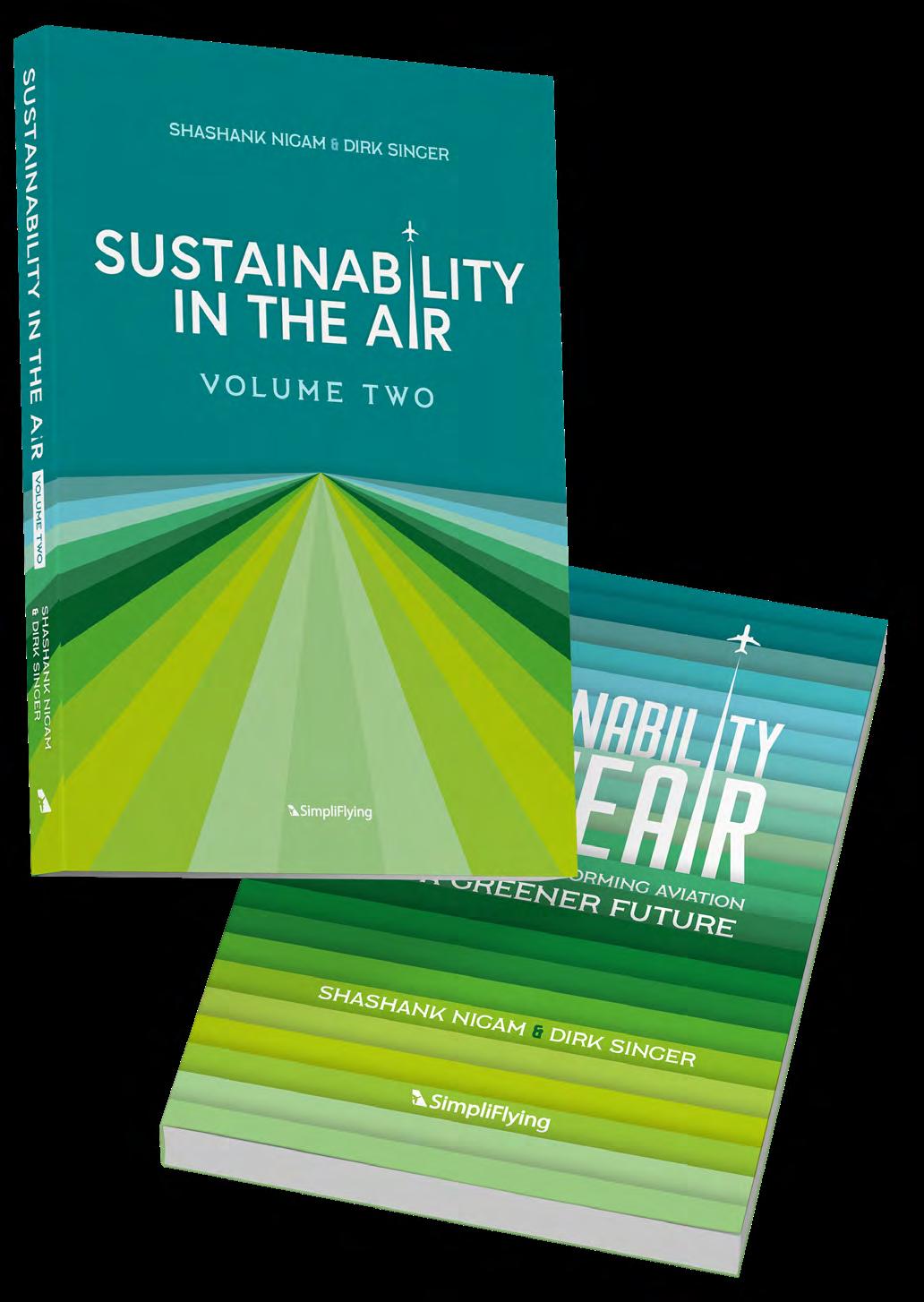

Climate change concerns are making the aviation industry turn to sustainable aviation fuel (SAF), electric, and hydrogen-powered aircraft to cut emissions. However, scaling these technologies requires significant innovation.
Sustainability in the Air Volume One & Two highlight the journeys of entrepreneurs, executives, and investors who are navigating these challenges and paving the way for the future of aviation.


